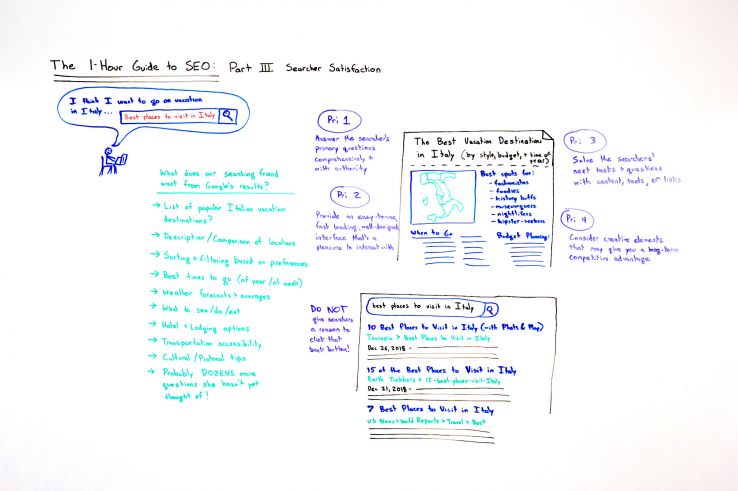So historically, if we were doing a guide to SEO in the long-ago past, we probably wouldn't even be talking about searcher satisfaction. But Google has made such a significant number of advances in the last 5 to 10 years that searcher satisfaction is now a huge part of how you can be successful in SEO. Now Google sorts those results in a number of ways. All of these things sort of feed into searcher satisfaction. But when you, as a content creator and as a search engine optimization professional, are creating and crafting content and trying to optimize that content so that it performs well in Google's results, you need to be considering what are all of these questions. is one of the most powerful ways to craft content that performs better than your competition in search engines, because it turns out a lot of people don't do this. Priority 3: Solve the searcher's next tasks and questions with content, tools, or links Priority three, I want to solve the searcher's next tasks and questions with either content on my own site or tools and resources or links or the ability to do them right here so that they don't have to go back to Google and do other things or visit other websites to try and accomplish the tasks, like figuring out a good hotel or figuring out the weather forecast. Priority 4: Consider creative elements that may give you a long-term competitive advantage Priority four is consider some creative elements, maybe interactive tools or an interactive map or sorting and filtering options that could give you a long-term, competitive advantage, something that's difficult for other people who want to rank for this search term to build. Over time, Google will figure out that US News & World Reports is not doing a good job of answering the searcher's query, of providing a satisfactory experience, and they will push them down in the results and they will push these other ones, that are doing a good job, up in the results. You want to be the result that satisfies a searcher, that gets into their head and answers their questions and helps them solve their task, and that will give you an advantage over time in Google's rankings.
Satisfying your searchers is a big part of what it means to be successful in modern SEO. And optimal searcher satisfaction means gaining a deep understanding of them and the queries they use to search. In this section of the One-Hour Guide to SEO, Rand covers everything you need to know about how to satisfy searchers, including the top four priorities you need to have and tips on how to avoid pogo-sticking in the SERPs.


Click on the whiteboard image above to open a high-resolution version in a new tab!
Video Transcription
Howdy, Moz fans, and welcome to our special edition One-Hour Guide to SEO Part III on searcher satisfaction. So historically, if we were doing a guide to SEO in the long-ago past, we probably wouldn’t even be talking about searcher satisfaction.
What do searchers want from Google’s results?
But Google has made such a significant number of advances in the last 5 to 10 years that searcher satisfaction is now a huge part of how you can be successful in SEO. I’ll explain what I mean here. Let’s say our friend Arlen here is thinking about going on vacation to Italy.

So she goes to Google. She types in “best places to visit in Italy,” and she gets a list of results. Now Google sorts those results in a number of ways. They sort them by the most authoritative, the most comprehensive. They use links and link data in a lot of different ways to try and get at that. They use content data, what’s on the page, and keyword data.
They use historical performance data about which sites have done well for searchers in the past. All of these things sort of feed into searcher satisfaction. So when Arlen performs this query, she has a bunch of questions in her head, things like I want a list of popular Italian vacation destinations, and I want some comparison of those locations.
Maybe I want the ability to sort and filter based on my personal preferences. I want to know the best times of year to go. I want to know the weather forecast and what to see and do and hotel and lodging info and transportation and accessibility information and cultural tips and probably dozens more questions that I can’t even list out here. But when you, as a content creator and as a search engine optimization professional, are creating and crafting content and trying to optimize that content so that it performs well in Google’s results, you need to be considering what are all of these questions.

COMMENTS